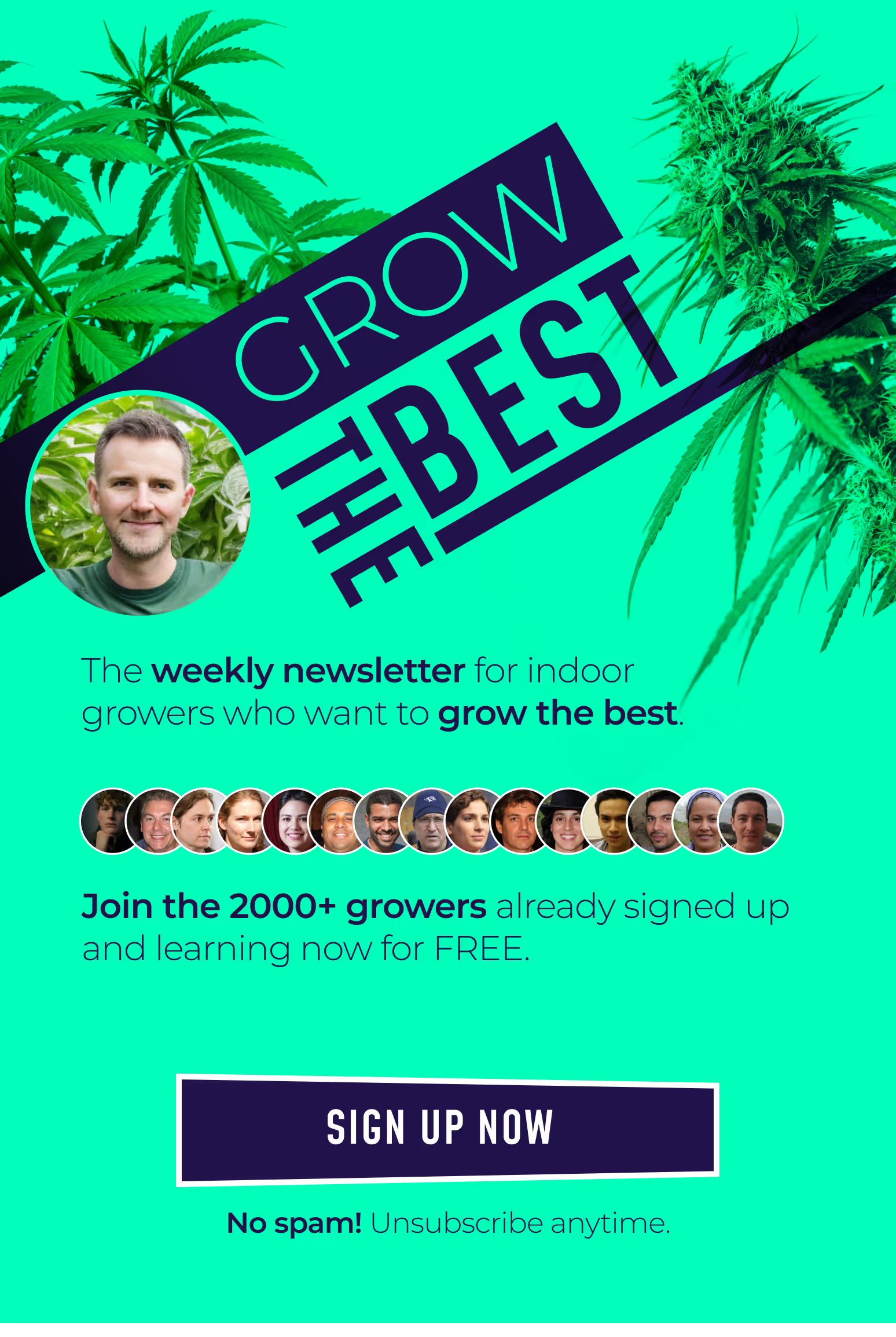Understanding seed feminisation: What you need to know


If you're not using feminised cannabis seeds, you could be wasting time, space, and effort on plants that won't produce a single bud.
The solution for cannabis growers looking to maximise their yield lies in understanding and using feminised seeds, and this post has all the answers you're looking for.
Imagine spending months carefully tending to your plants, only to discover that half of them are male and useless for your goals. Without the right strategy, this scenario could be your reality.
In this guide, we'll dive deep into feminising cannabis seeds, explaining what it is, how it works, why it can transform your growing experience and more.
If you're serious about growing indoors, achieving higher yields and eliminating the guesswork in your grow room, stick with us.
We've got the expertise to guide you, whether you're a beginner or an experienced grower looking to refine your approach.
Disclaimer: Any information given on this site is for educational purposes only. Please ensure if you’re growing cannabis, you’re doing so by the law and subject to appropriate permissions and licenses of the applicable country.
What is cannabis seed feminisation?
Feminisation is the process of producing feminised cannabis seeds that grow into female plants.
Unlike regular seeds, which have a roughly 50/50 chance of becoming male or female, feminised seeds are designed to give you up to 99% female plants.
This is a huge time-saver since you won't have to grow more plants than necessary or constantly check your grow room to identify and remove male plants that might ruin your crop by releasing pollen.
Feminised cannabis seeds are created by manipulating female plants to produce pollen, which is then used to pollinate other female plants.
The result of breeding two female plants? Seeds that carry only female genetics.
No more worrying about accidentally growing male plants that don’t produce buds or, worse, turning your entire crop into a seed-producing operation.
The science behind feminised cannabis seeds
Now, let’s get into the nitty-gritty of how feminised seeds are made. The most common methods involve using chemicals like colloidal silver, silver thiosulfate (STS), silver nitrate or gibberellic acid.
These substances are applied to a female plant during its growth cycle to stress it into developing male sex organs and male flowers.
Yes, you heard that right! A female plant can be induced to grow male flowers, and these flowers can then produce viable pollen.
Here’s how it works:
1. Application of colloidal silver or silver thiosulfate
You spray the plant with colloidal silver or a silver thiosulfate solution. Usually, starting during the vegetative stage and continuing until the plant begins to develop male flowers.
This treatment blocks ethylene, a hormone critical for female flower development, leading the plant to produce male pollen sacs instead.
2. Pollen collection and pollination
When you induce male flowers, those flowers on the treated plant produce pollen that contains only female chromosomes.
You then collect this pollen and use it to fertilise another female plant (or even the same one). The seeds that develop from this pollination will be feminised seeds.
By using these techniques, you’re able to create your own batch of feminised seeds, perfect for experimenting with new cannabis strains at home.

Advantages and disadvantages of feminised seeds
So, why go through all this trouble to create feminised seeds? Let’s break down the pros and cons.
Feminised seeds advantages:
Higher yields
Feminised seeds allow you to cultivate female plants only because female plants produce buds. You don't have to waste time and space on male plants that you’ll eventually need to discard.
Saves time and effort
By starting with feminised seeds, you can avoid the tedious process of sexing plants and removing males, which is especially helpful if you’re growing in a small space.
Efficiency and safety
Fewer plants to grow means you can operate more discreetly and manage your crop more efficiently, which is safer for many home growers.
Feminised seeds disadvantages:
Genetic uniformity
Because feminised seeds are typically derived from self-pollination or close genetic relatives, they can lack the genetic diversity that might make plants more resilient to diseases or pests.
Potential for hermaphrodites
If not correctly produced or grown under stressful conditions, feminised seed can still develop into hermaphrodite plants, which can grow hermaphrodite flowers and endanger your entire grow by self-pollinating.
Not suitable for breeding
While feminising seeds is a great way to experiment with new strains at home, remember that these seeds aren’t typically suitable for large-scale commercial breeding, as they lack the genetic testing and stability of professionally produced seeds.

Can I feminise my own seeds?
Yes, you can feminise your own seeds by spraying colloidal silver or STS on a female plant to induce male flower production.
This process creates pollen with only female chromosomes, which you can use to produce feminised or female seeds at home.
Techniques for feminising seeds at home
If you’re thinking about feminising your own seeds at home, you’re in for some fun experimentation.
Here’s a step-by-step guide to get you started:
- Choose your plants carefully: Start with healthy, robust female plants that you know produce high-quality buds. These will become your “mother plants.”
- Prepare your feminising agent: Whether you’re using colloidal silver, silver thiosulfate, or another agent, make sure you have the right concentration. You can make colloidal silver at home with distilled water and a small generator or buy a ready-made solution.
- Spray the plants at the right time: Timing is crucial in this delicate process. Start spraying your chosen plant with your feminising agent daily (paying close attention to nodes and bud sites) from the last weeks of the vegetative stage until you see male flower development. Be consistent and patient—this process can take several weeks.
- Isolate and collect pollen: Once the plant starts producing male flowers/pollen sacs, carefully collect the pollen in a dry environment. Be mindful of pollen drift — you don’t want to accidentally pollinate other plants in your grow room!
- Pollinate your female plants: Apply the pollen to another female plant, ideally in a controlled setting, to produce feminised seeds. At harvest time, the seeds developed on the female plant are collected. At this step, you can experiment with creating unique cannabis strains by selecting different mothers.

How long does it take to feminise seeds?
It takes about 2-3 weeks of spraying a female plant with colloidal silver or silver thiosulfate during the vegetative stage to induce male flower development.
This is followed by another 4-6 weeks for pollination and seed development, totalling around 6-9 weeks to produce feminised seeds.
Unlock premium growing secrets – join the Grow The Best newsletter!

Understanding pollination: Good or bad?
When you’re dealing with feminised seeds, understanding pollination is key.
Pollinating a female plant with its own pollen can be a quick way to produce seeds, but there are some things to consider:
- Self-pollination pros: Easy to do at home, doesn’t require male plants, and guarantees feminised seeds.
- Self-pollination cons: It can lead to inbreeding, reduce genetic diversity, and increase the risk of undesirable traits (like a tendency to hermaphrodite).
If you’re serious about creating stable genetics, consider using pollen from another female plant instead of self-pollination.
This can help maintain some genetic diversity while still achieving your goal of feminised seeds.

Feminised seeds vs autoflower and regular seeds
When choosing your seeds, it’s essential to understand the differences between autoflower, vs feminised seeds and regular seeds.
Each type has its unique characteristics and benefits, so let’s break it down:
Feminised seeds
- Pros: These types of cannabis seeds produce only female plants almost exclusively, which is ideal for growers focused on maximising bud production. You don’t have to worry about identifying and removing male plants, saving you time and effort.
- Cons: While feminised seeds are efficient, they may lack the vigour of normal seeds. Many growers feel that regular plants have more vitality and resistance to environmental stresses.
-
Autoflowering seeds
- Pros: Auto flowering seeds are designed to flower automatically after a certain period, regardless of light cycles. They are great for quick harvests and ideal if you want multiple crops in a single season.
- Cons: Autoflowering seeds generally yield less than feminised seeds and can have lower potency levels, which may not be ideal if you’re aiming for high-quality buds.
Regular seeds
- Pros: This type of seed can produce both male and female plants, offering a more genetically diverse crop. This diversity can lead to more robust male and female plants that can better resist pests and diseases.
- Cons: Since regular seeds have a 50/50 chance of being male or female, you must identify and remove male plants early to avoid unwanted pollination.
So, which should you choose? Feminised seeds are your best bet if your goal is maximum bud production with minimal hassle.
However, if you’re interested in breeding or experimenting with genetic diversity, don’t discount normal or autoflowering seeds. It all depends on your growing goals!

Best practices for growing feminised cannabis seeds
Now that you’re familiar with the benefits of feminised seeds let’s talk about how to grow them effectively.
Here are some best practices to ensure a successful harvest:
Create the ideal environment
Keep your grow room clean, well-ventilated, and at a stable temperature (around 21-29°C or 70-85°F). Feminised cannabis seeds thrive in consistent environments.
Choose the right light cycle
Start with an 18/6 light cycle during the vegetative growth stage and switch to a 12/12 cycle when you want to start flowering. This will encourage healthy growth and maximise yield.
Optimise watering and nutrients
Don’t overwater! Let the soil dry out a bit between watering. Use quality nutrients, especially during the flowering phase, to support bud production.
Monitor for pests and diseases
Keep a close eye on your plants, looking for signs of stress, pests, or mould. Using natural pest control methods can keep your crop healthy without affecting the quality of your buds.
Prevent hermaphroditism
Stress is the leading cause of hermaphroditism in feminised seeds. Avoid stressing your plants with drastic changes in temperature, irregular watering, or light leaks during the dark period of the flowering stage.
By following these tips, you’ll be well on your way to growing robust, healthy female cannabis plants that yield top-quality buds.

Common myths about feminised seeds debunked
Let’s clear up some common misconceptions about feminised seeds:
- Myth 1: Feminised seeds always produce hermaphrodites: Not true! While poorly made feminised seeds or stressful growing conditions can cause hermaphroditism, well-made feminised seeds grown in a stable environment are just as reliable as normal seeds.
- Myth 2: Feminised seeds are less potent: Again, not necessarily true. The potency of your cannabis depends more on genetics and growing conditions than whether the seed is feminised.
- Myth 3: Feminised seeds are only for beginners: While feminised seeds are great for beginners because they simplify the growing process, many experienced growers also prefer them for their efficiency and convenience.

Can you clone feminised seeds?
Absolutely! Cloning feminised seeds is a great way to replicate the characteristics of a plant you love without the unpredictability of starting from seed.
Here’s how you can do it:
- Select a healthy mother plant: Choose a robust, pest-free plant with the traits you desire. This will become your “mother plant.”
- Take cuttings in the vegetative stage: Use a clean, sharp blade to take cuttings from the plant while it’s still in the vegetative growth stage. Make sure each cutting has at least one node and a few healthy leaves.
- Root your cuttings: Place the cuttings in a rooting medium, like rock wool or coco coir, and keep them in a humid environment with plenty of indirect light until they develop roots.
- Transplant and grow: Once your clones have rooted, transplant them into your preferred growing medium and treat them like any other plant.
Cloning is an excellent technique for maintaining genetic consistency, ensuring that each new plant has the same qualities as the original.
Just remember that clones also inherit the risks of their parent plant, including susceptibility to pests or diseases.
Takeaways
And there you have it! By now, you should have a solid understanding of feminisation and how to make the most of feminised seeds in your cannabis garden.
From understanding what they are to learning how to create them yourself to navigating the advantages and potential pitfalls, you're well-equipped to make informed decisions about your next grow.
Remember, while feminised seeds offer convenience and efficiency, they're just one tool in your growing arsenal.
Whether you choose feminised, regular, or autoflowering seeds, the key is to stay curious, keep experimenting, and continue learning.
The world of cannabis cultivation is vast, and there’s always more to explore.
Happy growing
FAQs
Are feminised seeds bad?
Feminised seeds aren’t inherently bad, but they have some limitations you should know.
The primary advantage of feminised seeds is that they produce only female plants, which means you get more buds without worrying about male plants.
However, feminised seeds can be prone to becoming hermaphrodite plants if stressed, leading to unwanted male flower development and potentially pollinating your entire crop.
Some growers believe that normal seeds provide more vigour and genetic diversity, making them more resilient to pests and diseases.
Feminised cannabis seeds are also less ideal for breeding since they lack the genetic variation found in normal seeds.
Can a female cannabis seed turn male?
A female cannabis seed typically grows into a female plant, but under certain conditions, it can develop male characteristics and produce male flowers.
This usually happens because of stress factors like inconsistent light cycles, extreme temperatures, physical damage, or nutrient deficiencies.
When a female plant begins showing both female flowers and male flowers, it becomes a hermaphrodite plant.
Hermaphroditism is the plant's natural response to stress, aiming to produce seeds and ensure its survival.
However, this isn’t ideal for growers, as a female plant that turns male can release pollen and pollinate your crop, leading to seeded buds instead of the high-quality, seedless buds most growers desire.
To minimise the risk, it’s essential to maintain a stable growing environment and avoid stressing your plants.
Using feminised seeds, grown under optimal conditions, reduces the likelihood of your female cannabis plants developing male traits, ensuring they continue to produce buds rather than seeds.
How do you feminise male seeds?
Feminising male seeds is technically impossible because male seeds from male cannabis plants, by their genetic makeup, can only produce male cannabis plants.
However, you can feminise regular seeds (which have the potential to be either male or female) by inducing a female plant to produce male flowers and viable pollen using methods like colloidal silver or silver thiosulfate.
You can then use this pollen to fertilise another female plant, resulting in feminised seeds.
Remember, the goal is to create seeds that grow into only female plants, so starting with female plants and inducing them to produce pollen is key.
Are feminised seeds 100% female?
Feminised seeds are designed to produce only female plants, but they aren’t guaranteed to be 100% female in every case.
The success rate of feminised seeds typically ranges between 99% and 100%, meaning there's still a small chance that a seed could develop into a male plant or a hermaphrodite plant under certain conditions.
To achieve the best results, it’s crucial to provide a stable growing environment and closely monitor your plants.
While feminised seeds offer an incredibly high likelihood of producing female cannabis plants, they are not completely foolproof.
Are regular seeds feminised?
No, regular seeds are not feminised. They can produce either male or female cannabis plants, with about a 50/50 chance for each.
Unlike feminised seeds, which are specifically bred to produce only female plants, regular seeds provide a natural mix of both genders.
This makes them ideal for breeders who want genetic diversity but less predictable for those focused on bud production.
Do feminised seeds hermaphrodite?
Yes, feminised seeds can become hermaphrodite plants under stress conditions like inconsistent light cycles, extreme temperatures, or physical damage.
Can you mother feminised seeds?
Yes, you can use feminised seeds to create a mother plant. A mother plant grown from feminised seeds can provide consistent clones that retain the desired traits.
However, some growers find that feminised cannabis plants may be more prone to hermaphroditism over time, so careful monitoring is needed to ensure the quality of the mother plant and its clones.
What is the success rate of feminised seeds?
The success rate of feminised seeds is typically around 99%, meaning they almost always produce female plants.
However, a small percentage may still develop male flowers or become hermaphrodites because of stress or unstable genetics.
Proper care and a stable environment are key to maximising the success of feminised cannabis seeds.
How do they guarantee female seeds?
To guarantee female seeds, breeders use methods like applying colloidal silver or silver thiosulfate to a female plant to induce male flowers.
This produces pollen that contains only female chromosomes, which is then used to pollinate another female plant.
This process ensures that the resulting seeds are nearly 100% female cannabis seeds.
Do commercial growers use feminised seeds?
Yes, many commercial growers and home growers use feminised seeds to maximise bud production since these seeds produce only female plants, which produce buds.
This approach reduces the need to identify and remove male plants, saving time and space while ensuring higher yields of female cannabis flowers.
Get the latest grow tips – subscribe to the Grow The Best newsletter now!











.avif)








